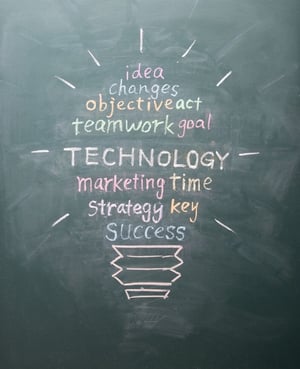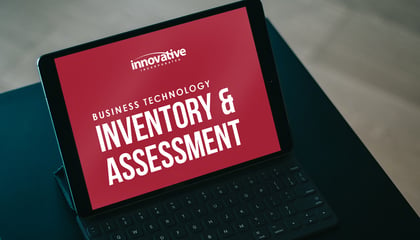Benefits of an IT Strategy
 Your business plan informs your go-to-market strategy. It includes a thorough market analysis and assessment of your competition. It tells you how you’ll market yourself. It identifies the human and financial capital you’ll need to deliver your products and services.
Your business plan informs your go-to-market strategy. It includes a thorough market analysis and assessment of your competition. It tells you how you’ll market yourself. It identifies the human and financial capital you’ll need to deliver your products and services.
Often, your business plan reduces IT resources to a sentence or two. They're included as part of your initial start-up costs or employee equipment expenses. This is enough to get you up and running, but you most likely don’t think about IT needs again until something breaks.
Failing to continuously evaluate and plan for IT needs is necessary to protect your business. A lack of an IT strategy will result in unplanned expenses and inefficiencies. At worst it could even cause a catastrophic data loss. An IT strategy aligned with your business strategy does this for you.
You’re already investing in IT on some level. Why wouldn’t you want to put the right plans in place to make it work for you?
What is an IT Strategy?
An IT strategy is a document that outlines the technology you need to run your business. It covers all facets of technology in your business including:
- Electronic Data
- Software and Applications
- Hardware and Equipment
- Network and Connectivity
- Communication Channels
- Print and Copy Solutions
- Cyber security
- Compliance
Your CIO or IT department leader should help guide your IT strategy. If you don’t have an internal IT department an IT managed service provider can fill this strategic role.
What Does an IT Strategy Do for Your Business?
An IT strategy helps you determine what technology you need to invest in to meet your identified business goals.
Your IT strategy should document things like:
- Hardware replacement schedules
- Software license renewals
- Equipment warranties
- Vendors
- Network redundancies
Your IT strategy also identifies the technologies necessary for critical business functions. As you plan for growth you will adopt new or expanded business functions. Your IT strategy will identify the technology necessary to support your planned growth.
As a result of your IT strategy, you will experience better budget planning, less emergency expenses, and increased up-time.
Improved Budget Planning
An IT strategy informs your budget process in three ways. (expand here and add subheadings)
1. LIFE CYCLE Management
Your IT strategy should include a life cycle management plan for every device. The average lifespan of computers and servers is 3-5 years. Planning for replacements in advance allows you to budget for necessary replacements each year. Ideally, you’ll stagger your replacement schedule so that you’re making even investments in replacements each year. Things never break at a convenient time. Planning for replacements and upgrades in advance avoids unnecessary and unplanned downtime.
2. Software Upgrades and Licensing Renewals
Software and infrastructure upgrades are necessary to maintain compliance and operations. Your IT strategy plans for these in advance. For example, Microsoft announced the end of support for Windows 7 at least one year in advance of the January 14, 2020 end of support date. This gave users time to plan for an upgrade. An unsupported operating system has serious security and compliance consequences. It also creates compatibility issues with newer hardware and software. Your IT strategy should inform you in advance of planned upgrades so that you’re not faced with a large, unexpected bill.
3. New Equipment
An IT strategy informed by your business strategy identifies the IT resources necessary for changes in the business. These changes could be new employees, new product lines, or increased workloads. With this knowledge, you can plan the IT investments necessary for projected growth.
Decreased Emergency Expenses
Technology breaks. It’s a fact of life.
The good news is that more planning equals fewer emergency expenses.
Properly maintained, updated, and right-sized IT systems break a lot less often. An IT strategy informs you of the maintenance, upgrades, and capacity of the IT systems you need today and those you’ll need in the future.
As IT systems improve by following a sound IT strategy, emergencies and unplanned expenses are reduced over time. This allows you to make investments in technology that has a measurable impact on the business, not just in fixing what you have.
Increased UP-TIME
Most businesses are almost paralyzed when IT systems aren’t working. When the network goes down it only takes a few minutes for employees to start gathering around the water cooler twiddling their thumbs and catching up with each other about their latest Netflix binges.
An IT strategy identifies your most mission-critical systems and data and plans for necessary redundancies and backups to keep you up even when an element of your network goes down.
The easiest example of a strategy that increases up-time is your data backup strategy. Your backup should not only back up the right data at the right points in time but be restored in an acceptable length of time.
Related Article: Learn how two different backup strategies resulted in two very different results in similar ransomware attacks.
Additionally, if you rely on any data or applications in the cloud, your IT strategy should address a redundant internet connection to protect your operations in the event of an internet outage.
Related Article: Things to Consider Before Moving to the Cloud
In a Nutshell: An IT Strategy is Good for Your Overall Business Health
At the end of the day, every business decision you make is intended to improve the health of your business. An IT strategy allows you to use technology as a tool for a healthier business, rather than just another necessary cost of keeping the doors open. When IT systems align with your business strategy, technology becomes a vehicle for business growth and opportunity.




